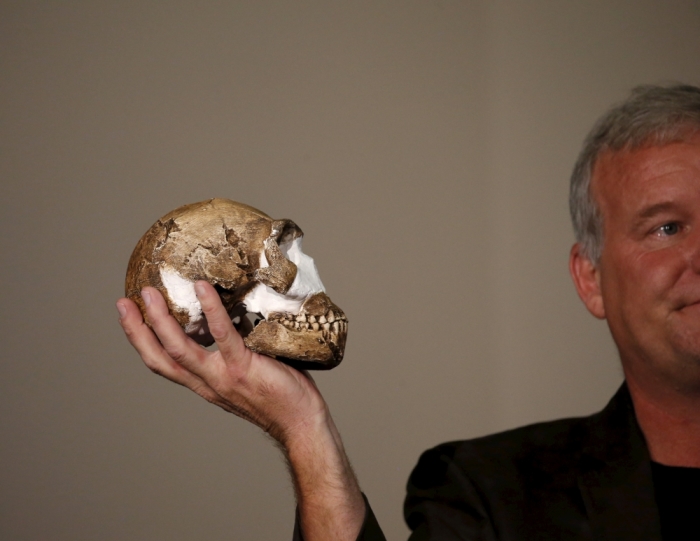Hominid Hype and Homo Naledi: Did Scientists Really Discover a Human Ancestor?

Whenever a new hominin fossil is discovered, the newsmedia eagerly seizes the opportunity to go on a crusade for Darwin. The Internet is thus currently buzzing about the discovery of a new species, Homo naledi, represented by hundreds of bones found in a cave near Johannesburg, South Africa.
The find is spectacular to be sure because it represents such large cache of hominin bones. In a field where a single scrap of jaw gets everyone excited, this is a big deal. But do we know that Homo naledi is the "human ancestor" that CNN, PBS, NBC, and many others are calling it? Dig into the details, and the answer is "no."
The main claim about Homo naledi is that it is a small-brained (compared to humans) hominin with a trunk similar to the apelike australopithecines, and with humanlike hands and feet. But even some of those supposedly humanlike traits are unique. Unlike humans, its hands had long, curved fingers that were tailored for climbing. Overall the species is unique. As Lee Berger, the lead scientist who discovered the find admitted in New Scientist, "It doesn't look a lot like us."
For now, the promoters of Homo naledi are calling it an "anatomical mosaic." That terminology raises a red flag. In the parlance of evolutionary biology, that usually means the fossil is a unique organism that doesn't fit easily into the standard evolutionary tree.
Indeed, just four years ago Australopithecus sediba — also discovered and promoted by Berger — was the transitional form du jure between the australopithecines and our own genus Homo. Yet sediba had a very different set of traits from naledi. If the same researchers now want to advocate Homo naledi as the new "transitional form," they must radically revise their evolutionary story. Both species been called a "human ancestor," in recent years, but both claims cannot be true.
Another major challenge to claims for Homo naledi as a transitional form is the fact that the age of these newly reported fossils is currently totally unknown. For all we presently know, the fossils could be very young (say, less than 250,000 years old), and far removed from any hypothetical evolutionary transition between Australopithecus and Homo.
Homo naledi's promoters are suggesting it is between 2.5 and 3 million years old. But that date isn't the result of an objective geological dating analysis. Rather, that date is driven strictly by evolutionary considerations, because we have very few bones from that time period and very little to document the supposed transition between the apelike australopithecines and the humanlike members of Homo.
At present, there's no geological evidence that this species is from that time period and plugs some "gap" in the fossil record. Claims that it is a human ancestor are driven by hype, not evidence.
Yet another controversy over "naledi" is whether it represents a single species. The fossils' discoverers want the bones to all be from one single species so they can declare they found a hominin with a small head, an ape-like trunk, but humanlike hands and feet.
But Jeffrey Schwartz, an anthropologist at the University of Pittsburgh, argued in Newsweek that the bones represent not one species but at least two, because of the differing shapes of various skulls found in the cave. If multiple species are present, the evolutionary model being promoted by naledi's discoverers falls apart.
A third dubious claim making rounds in the media is that Homo naledi ritualistically buried its dead — a testimony to its supposedly human-like intellect. At best, it's not the case that this species buried its dead in any manner like we do. In fact, the bones weren't buried in the ground. Rather, it seems like the bodies were just tossed into the back crevice of a cave and left there to rot.
The cave's layout also means that if this species did "bury" its dead, then it would have had to crawl far back into a deep dark cave, dragging a body through narrow crevices. That's difficult for any animal to do, and some have suggested it would require using torches. But this species had a small brain not much larger than a chimp — the use of fire and burial by torchlight seems highly unlikely.
So how did these individuals end up in the back of the cave where they died? More likely, over the millennia various unfortunate hominins found the cave as a convenient place to flee from African predators, perhaps a lion or a cheetah. In desperation, they fled into the deep darkness of the cave where they got stuck or lost.
Perhaps they were afraid to leave the cave. Perhaps it was too dark to find their way out. In any event, they died there in the back of the cave.
This explanation is more consistent with the evidence, so why do naledi's discoverers claim the species ritualistically buried its dead? It's simple: they want a small-brained species with human-like behavior. Evolutionary considerations, not evidence, again, are driving the conclusions.
Lastly, there are controversies about whether "Homo" naledi even belongs in our own genus Homo. Biological classification is highly subjective, but given the species's small brain size and its australopithecine-like body, it's placement within Homo has already proven controversial.
Four years ago the media was claiming Australopithecus sediba was the newest human ancestor. But cooler heads prevailed and it was shown that sediba was from the wrong time period and had the wrong traits to be a link between humanlike members of the genus Homo and the apelike australopithecines.
What will become of "Homo naledi" remains to be seen. So far, however, its pathway resembles other hominin fossils whose "transitional" or "ancestral" status ultimately went belly up. When evaluating media claims of a "human ancestor," a strong dose of healthy skepticism is warranted.





























